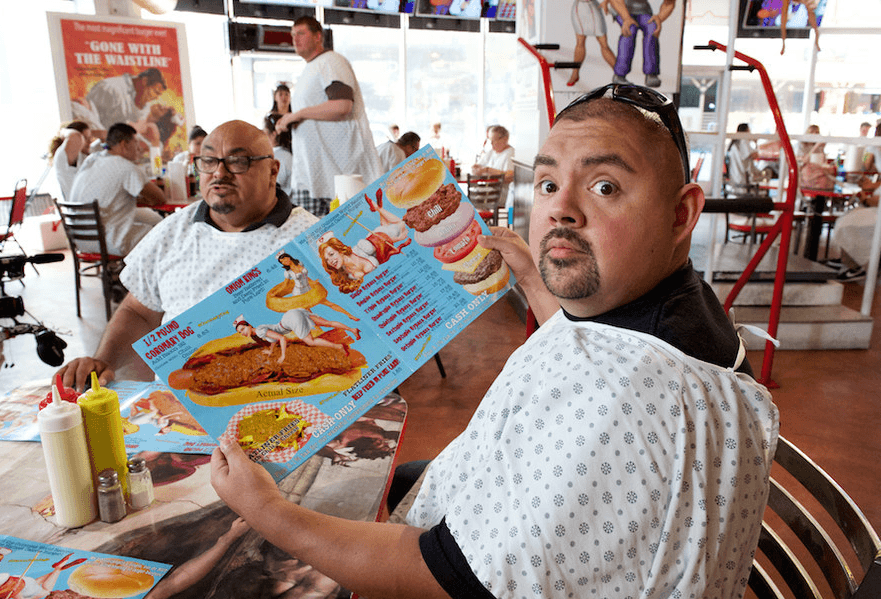 Gabriel Iglesias in a hospital gown while ordering food
Gabriel Iglesias in a hospital gown while ordering food
Wiping his sweaty palms on his shorts, Gabriel Iglesias mustered up enough courage to ask, ?How long do I have exactly?? as he sat in the doctor?s office after learning that he has Type II Diabetes. Little did Iglesias know that the next two words that came out of the doctor?s mouth would change his life. ?Two years.? He had only two years to live if he was to continue this lifestyle. Two years.
Gabriel Iglesias, one of America?s most prominent comedians, used to be 445 lbs and was given two years to live. Now, he?s lost over a hundred pounds and has a very successful road ahead of him. Better known by his nickname, Fluffy, Gabriel Iglesias has thousands of fans all over the world. Most of his stand-up jokes are about his personal life story, which consists of friends, family, and food. A lot of his comedy revolves around his weight and his love for food, which he embraces. Iglesias is not ashamed of his weight; he says people ask him all the time, ??Don?t you want to live to be a hundred??, to which he answers, ?well not if I can?t eat tacos!? This witty comeback accurately encapsulates Iglesias? comical character and his body positivity that allows him to have the perfect balance of humor and meaningfulness.
?I used to say that there were Five Levels of Fatness. Reason why I say, ?Used to say? is because now there are six! Uh-huh, I met the new one in Las Cruces. The original five levels are Big, Healthy, Husky, Fluffy, and DAMN! People ask, ?What could be bigger than DAMN!? The new level?s called ?OH HELL NO!? What?s the difference? You?re still willing to work with level five. Example, if you?re on an elevator and you?re with your friend and this really big guy gets on and you and your friend look at each other and you?re like, ?DAAAMN!? But you still let the big guy ride your elevator. That?s the difference. Level six, you see walking towards your elevator, [Deep growling noise] [Pretends to be a shocked passenger and starts pushing the ?close door? button.] ?OH HELL NO!? [Growl] ?NO!!? [Growl] ?NO!!?[Pretends to kick the fat man out] That?s the difference. The guy that I met was six foot eight, six hundred and fourteen pounds. Uh-huh, OH HELL NO!! And he was offended at my show. Not by anything that I said, but because of the fact that now at the shows I started selling T-shirts and apparently, I didn?t have his size. Keep in mind, I go all the way up to 5X on the T-shirts and he was like, [Deep growling voice] ?You don?t have my size.? I was like, ?Dude, I didn?t know they MADE you! I have up to 5X, I don?t have [Growl] X!??
-Excerpt from I?m Not Fat? I?m Fluffy (2009)
 Gabriel Iglesias introducing the sixth level of fatness
Gabriel Iglesias introducing the sixth level of fatness
A very crucial part of Iglesias?s stand-up shows is his animated personality. Iglesias demonstrates mastery with his vocal talent and adapts his voice based on the characters in his joke. His voices range widely from ?preppy white girl? to ?old southern man,? and he even incorporates sound effects with his voice such as cop sirens and bell dings. His use of sound helps to animate his jokes and brings the audience into the story?s setting. In this specific bit, his voice is the actual punchline and has a great impact on the audience. The sounds in the jokes are fundamental in the success of his jokes. As Iglesias introduces the sixth level of fatness, he uses a deep monstrous growl, as if people in this level are not people, but animals. Iglesias incorporates elements into the joke like how an author incorporates elements into a story by using personification, a widely used notion where nonhuman things are commonly given human characteristics. Iglesias tells jokes that incorporate elements of surprise. Doing what is different from the norm by dehumanizing human beings into simple animals or monsters, the audience is shocked, creating a more comical joke. Furthermore, he illustrates his comical personality by making realistic situations ridiculous, showing a contrast between the normal and the absurd. This manipulation of his setting is illustrated as Iglesias uses the elevator example where he changes the otherwise normal setting into a setting of fear. Iglesias?s elevator example is used to elicit an even greater roar of laughter from the audience. In addition, he uses this contrast between the normal and absurd through the exceptionally quick escalation of his ?levels of fatness.? He starts off this bit by naming the first four levels of fatness: big, healthy, husky, and fluffy, of which he includes himself. However, the level right above his is ?DAMN!? and there is a very visible gap between fluffy and ?DAMN!? in the way he portrays it through his voice. However, when it seems as if there can be no level worse than ?DAMN!?, Iglesias hits the audience with the sixth level: ?OH HELL NO!? In this way, Iglesias uses his comical character, outlandish voices, and contrasts between normal and absurd to deliver the biggest punchline of the joke, perfectly capturing the way his humor is built.
In today?s society, being overweight (or in his terms being ?fluffy?) is often ridiculed or looked down on. However, Gabriel Iglesias does not look down on overweight people such as himself. Instead, he makes light of them in his jokes and in this way develops a medium to celebrate the comedic value of his weight, and ultimately pass on body positivity. He finds himself in a special position considering that if an outsider were to make similar jokes against the obese, it would be unacceptable and viewed as rude and distasteful. However, due to his own weight, Gabriel Iglesias is given the opportunity to talk about a situation and find the humor out of it, allowing him to tackle the cultural prejudice against overweight people. He further utilizes this platform by making a connection between others who may be viewed as overweight and outsiders of that situation by talking about his love of food. In this way, Iglesias not only garners laughter from his heaviness but also an acceptance of overweight people and essentially, spreads body positivity and self-esteem.
Ultimately, Gabriel Iglesias uses both his high-spirited persona and his body positivity to reach various types of people through his comedy. He does not use his jokes trivially, but makes the most out of them by making the realistic into ridiculous and giving his work charismatic qualities. By giving his words animation, Iglesias makes his jokes enjoyable and humorous to listeners of all ages. Additionally, he is able to mitigate the great divide among the overweight and the outsiders through his comical quotes that are accepted by both groups. In conclusion, Gabriel Iglesias does an astounding job of bringing together people of differing crowds through his comedy.
Works Cited
?Gabriel Iglesias: Funny, ?Hot And Fluffy?.? NPR, NPR, 28 June 2012, www.npr.org/2012/06/28/155913657/gabriel-iglesias-funny-hot-and-fluffy.


